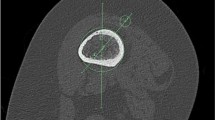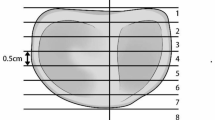Abstract
The purpose of the present study was to investigate whether an increased quadriceps angle (Q-angle) has an effect on patellar positioning and/or the thickness of the medial and lateral tibiofemoral and patellofemoral articular cartilage and menisci, in a group of young asymptomatic individuals. These individuals were detected in a previous study with a decreased anatomical cross-sectional area of the vastus medialis and lateralis as a result of an increased Q-angle. Patellar positioning and the thickness of the articular cartilages were determined in 19 asymptomatic male individuals with high Q-angle (HQ-angle) (18.5° ± 2.6°) using magnetic resonance imaging (MRI). Seventeen male counterparts with low Q-angle (10.1° ± 1.9°) were used for comparison. The position of the patella was determined by measuring the sulcus angle, the lateral patella tilt, the patella-lateral condyle index and the bisect offset (BSO) with the quadriceps relaxed. The BSO, was also measured with the quadriceps under maximum isometric voluntary contraction. The thickness of the articular cartilages of the lateral and medial femoral condyles, the tibial condyles, the patellar facets and the menisci were also measured. Our data revealed that healthy individuals with HQ-angle are unlikely to demonstrate any changes in the position of the patella and/or the thickness of the knee articular cartilages. The decreased anatomical area of the vastus medialis and an almost equally atrophied vastus lateralis, which was previously observed in this group of individuals may prevent in part the misalignment of the patella and early wear of the tibiofemoral and patellofemoral articular cartilages.






Similar content being viewed by others
References
Ando T (1999) Factors affecting the rectus femoris-patellar tendon Q-angle, measured using a computed tomographic scan. J Orthop Sci 4:73–77
Baecke JA, Burema J, Frijters JE (1982) A short questionnaire for the measurement of habitual physical activity in epidemiological studies. Am J Clin Nutr 36:936–942
Biedert RM, Warnke K (2001) Correlation between the Q angle and the patella position: a clinical and axial computed tomography evaluation. Arch Orthop Trauma Surg 121:346–349
Brossmann J, Muhle C, Schroder C et al (1993) Patellar tracking patterns during active and passive knee extension: evaluation with motion-triggered cine MR imaging. Radiology 187:205–212
Bruns J, Volkmer M, Luessenhop S (1993) Pressure distribution at the knee joint influence of varus and valgus deviation without and with ligament dissection. Arch Orthop Trauma Surg 113:12–19
Conlan T, Garth WP Jr, Lemons JE (1993) Evaluation of the medial soft-tissue restraints of the extensor mechanism of the knee. J Bone Joint Surg Am 75:682–693
Davies AP, Costa ML, Shepstone L et al (2000) The sulcus angle and malalignment of the extensor mechanism of the knee. J Bone Joint Surg Br 82:1162–1166
Eckstein F, Tieschky M, Faber SC et al (1998) Effect of physical exercise on cartilage volume and thickness in vivo: MR imaging study. Radiology 207:243–248
Eckstein F, Winzheimer M, Hohe J et al (2001) Interindividual variability and correlation among morphological parameters of knee joint cartilage plates: analysis with three-dimensional MR imaging. Osteoarthritis Cartilage 9:101–111
Fabry G, Cheng LX, Molenaers G (1994) Normal and abnormal torsional development in children. Clin Orthop Relat Res 302:22–26
Gilleard W, McConnell J, Parsons D (1998) The effect of patellar taping on the onset of vastus medialis obliquus and vastus lateralis muscle activity in persons with patellofemoral pain. Phys Ther 78:25–32
Grelsamer RP, Klein JR (1998) The biomechanics of the patellofemoral joint. J Orthop Sports Phys Ther 28:286–298
Guerra JP, Arnold MJ, Gajdosik RL (1994) Q angle: effects of isometric quadriceps contraction and body position. J Orthop Sports Phys Ther 19:200–204
Harrington IJ (1983) Static and dynamic loading patterns in knee joints with deformities. J Bone Joint Surg Am 65:247–259
Hirokawa S (1992) Effects of variation on extensor elements and operative procedures in patellofemoral disorders. J Biomech 25:1393–1401
Hsu RW, Himeno S, Coventry MB et al (1990) Normal axial alignment of the lower extremity and load-bearing distribution at the knee. Clin Orthop Relat Res 225:215–227
Huberti HH, Hayes WC (1984) Patellofemoral contact pressures The influence of Q-angle and tendofemoral contact. J Bone Joint Surg Am 66:715–724
Hungerford DS, Barry M (1979) Biomechanics of the patellofemoral joint. Clin Orthop Relat Res 144:9–15
Jones G, Glisson M, Hynes K et al (2000) Sex and site differences in cartilage development: a possible explanation for variations in knee osteoarthritis in later life. Arthritis Rheum 43:2543–2549
Karvonen RL, Negendank WG, Teitge RA et al (1994) Factors affecting articular cartilage thickness in osteoarthritis and aging. J Rheumatol 21:1310–1318
Kujala UM, Kormano M, Österman K et al (1992) Magnetic resonance imaging analysis of patellofemoral congruity in females. Clin J Sport Med 2:21–26
Livingston LA (1998) The quadriceps angle: a review of the literature. J Orthop Sports Phys Ther 28:105–109
Minkoff J, Fein L (1989) The role of radiography in the evaluation and treatment of common anarthrotic disorders of the patellofemoral joint. Clin Sports Med 8:203–260
Mizuno Y, Kumagai M, Mattessich SM et al (2001) Q-angle influences tibiofemoral and patellofemoral kinematics. J Orthop Res 19:834–840
Olerud C, Berg P (1984) The variation of the Q angle with different positions of the foot. Clin Orthop Relat Res 191:162–165
Powers CM, Shellock FG, Pfaff M (1998) Quantification of patellar tracking using kinematic MRI. J Magn Reson Imaging 8:724–732
Sasaki T, Yagi T (1986) Subluxation of the patella investigation by computerized tomography. Int Orthop 10:115–120
Tiberio D (1987) The effect of excessive subtalar joint pronation on patellofemoral mechanics: a theoretical model. J Orthop Sports Phys Ther 9:160–165
Tsakoniti AE, Stoupis CA, Athanasopoulos SI (2008) Quadriceps cross-sectional area changes in young healthy men with different magnitude of Q angle. J Appl Physiol 105:800–804
Waterton JC, Solloway S, Foster JE et al (2000) Diurnal variation in the femoral articular cartilage of the knee in young adult humans. Magn Reson Med 43:126–132
Acknowledgments
The authors gratefully acknowledge all the participants for the effort devoted to this study. This study was supported by the Secretariat General of Research and Technology and the European Union.
Author information
Authors and Affiliations
Corresponding author
Rights and permissions
About this article
Cite this article
Tsakoniti, A.E., Mandalidis, D.G., Athanasopoulos, S.I. et al. Effect of Q-angle on patellar positioning and thickness of knee articular cartilages. Surg Radiol Anat 33, 97–104 (2011). https://doi.org/10.1007/s00276-010-0715-4
Received:
Accepted:
Published:
Issue Date:
DOI: https://doi.org/10.1007/s00276-010-0715-4




